2023年中考英语一轮复习 第三课时 七年级下册(Unit 1~Unit 4)课件(共50张PPT)
文档属性
| 名称 | 2023年中考英语一轮复习 第三课时 七年级下册(Unit 1~Unit 4)课件(共50张PPT) |  | |
| 格式 | pptx | ||
| 文件大小 | 758.5KB | ||
| 资源类型 | 教案 | ||
| 版本资源 | 人教新目标(Go for it)版 | ||
| 科目 | 英语 | ||
| 更新时间 | 2023-05-27 10:10:03 | ||
图片预览

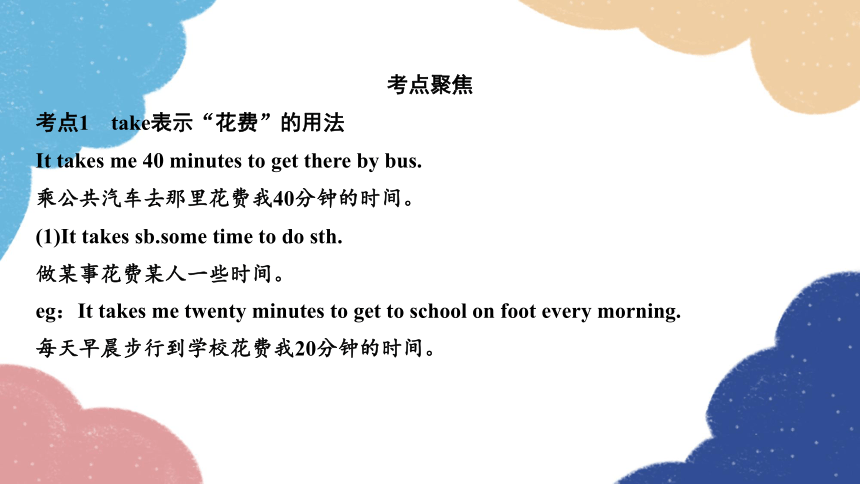
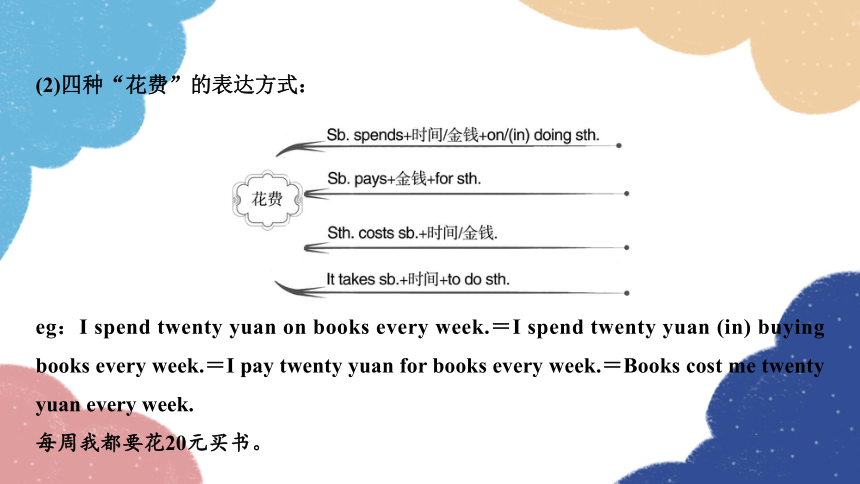
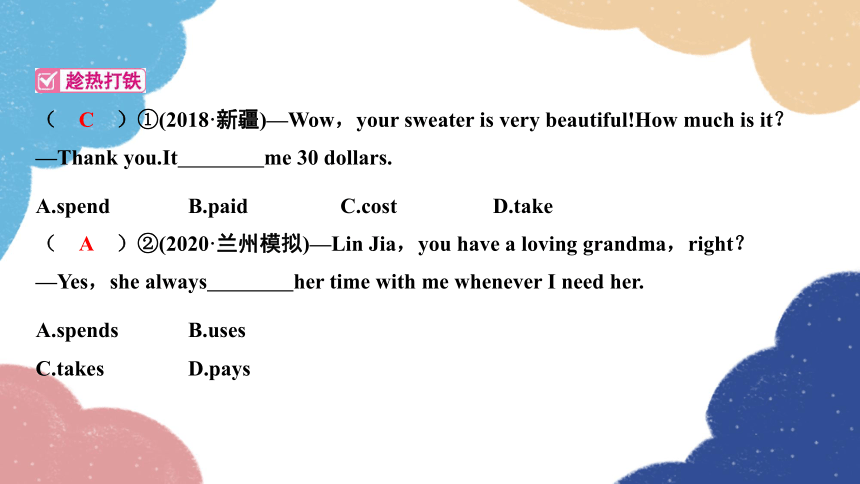
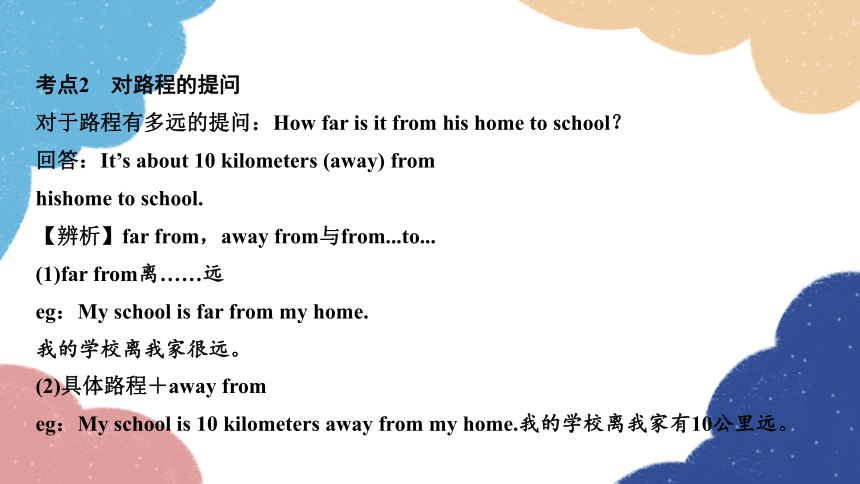
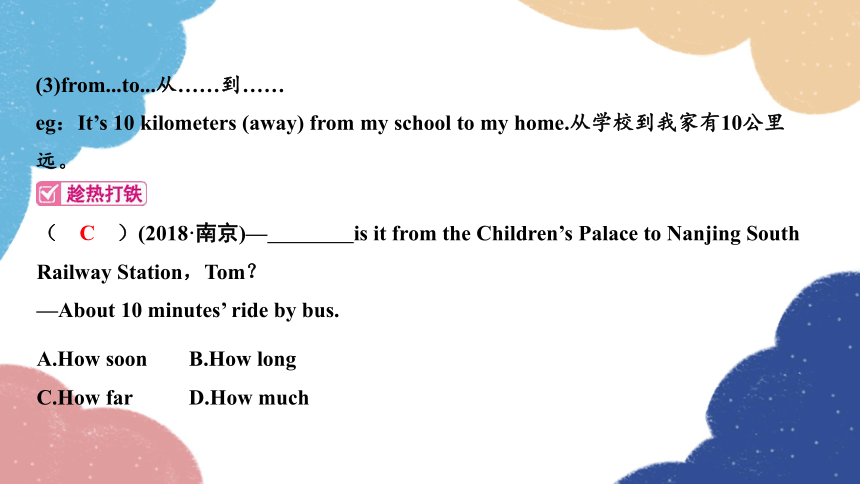
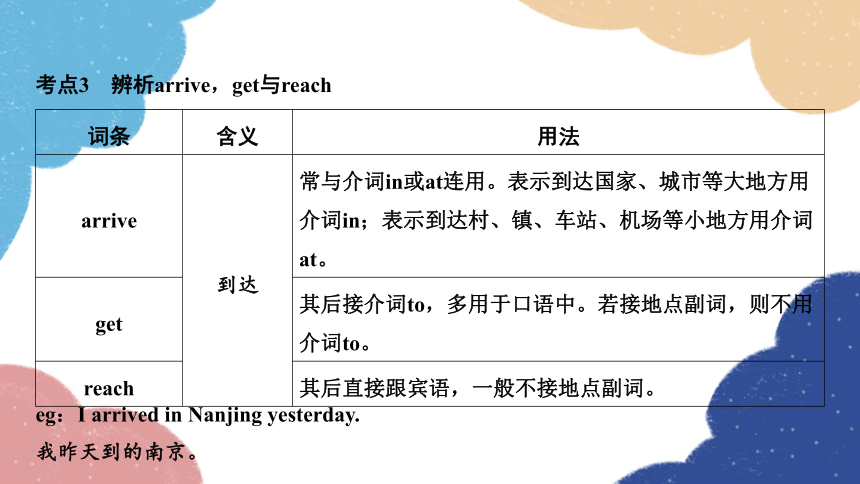
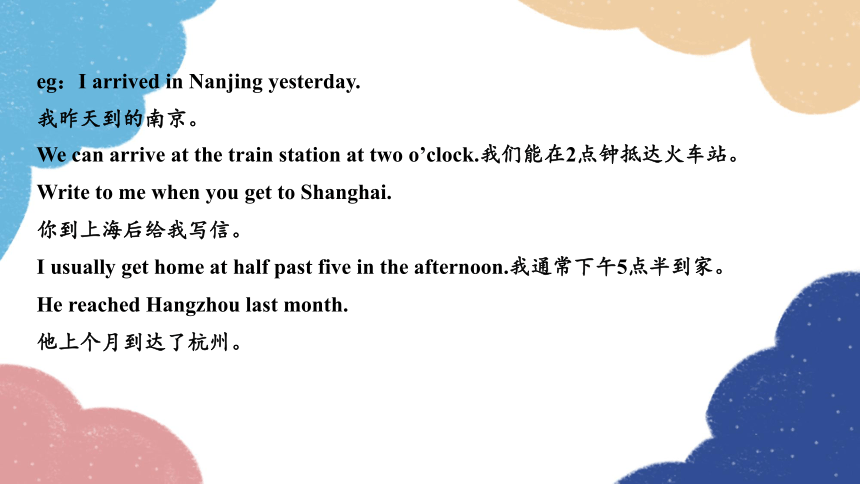
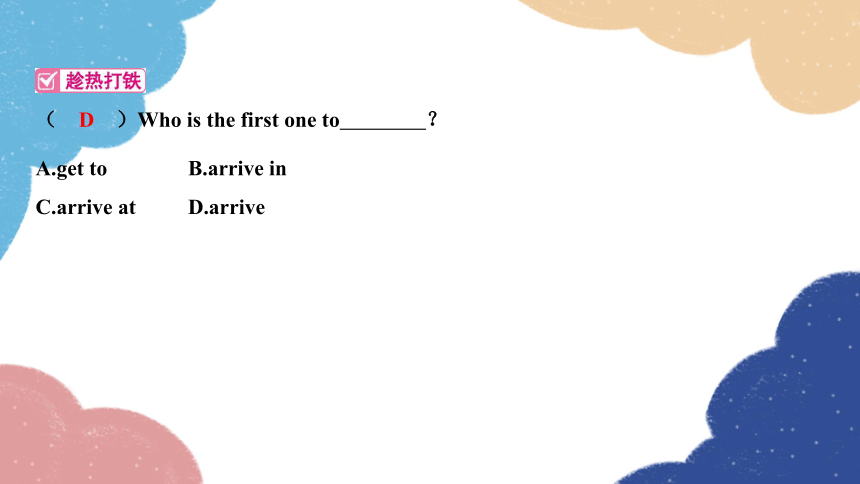
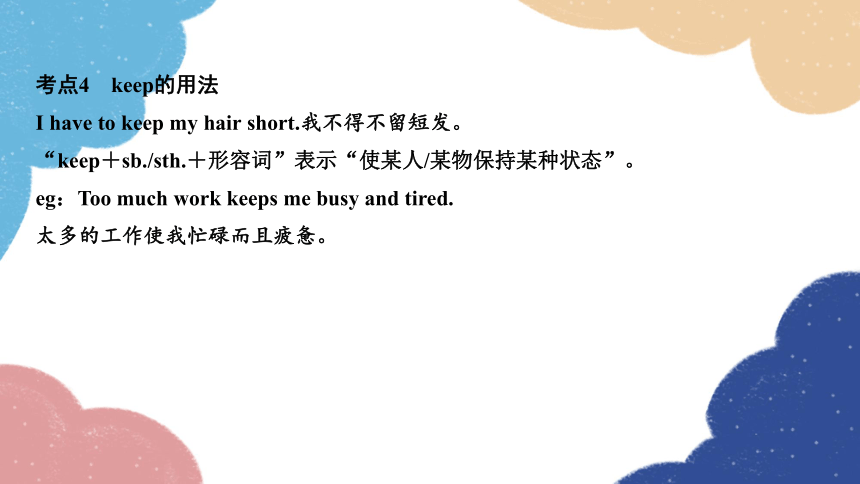

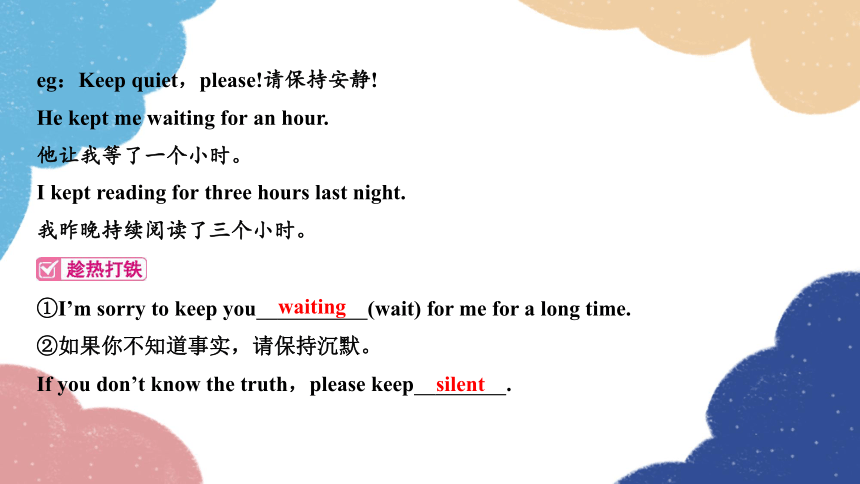
文档简介
(共50张PPT)
第三课时 七年级下册
(Unit 1~Unit 4)
第一章 课本再现
考点聚焦
考点1 take表示“花费”的用法
It takes me 40 minutes to get there by bus.
乘公共汽车去那里花费我40分钟的时间。
(1)It takes sb.some time to do sth.
做某事花费某人一些时间。
eg:It takes me twenty minutes to get to school on foot every morning.
每天早晨步行到学校花费我20分钟的时间。
(2)四种“花费”的表达方式:
eg:I spend twenty yuan on books every week.=I spend twenty yuan (in) buying books every week.=I pay twenty yuan for books every week.=Books cost me twenty yuan every week.
每周我都要花20元买书。
( C )①(2018·新疆)—Wow,your sweater is very beautiful!How much is it?
—Thank you.It me 30 dollars.
A.spend B.paid C.cost D.take
( A )②(2020·兰州模拟)—Lin Jia,you have a loving grandma,right?
—Yes,she always her time with me whenever I need her.
A.spends B.uses
C.takes D.pays
C
A
考点2 对路程的提问
对于路程有多远的提问:How far is it from his home to school?
回答:It’s about 10 kilometers (away) from
hishome to school.
【辨析】far from,away from与from...to...
(1)far from离……远
eg:My school is far from my home.
我的学校离我家很远。
(2)具体路程+away from
eg:My school is 10 kilometers away from my home.我的学校离我家有10公里远。
(3)from...to...从……到……
eg:It’s 10 kilometers (away) from my school to my home.从学校到我家有10公里远。
( C )(2018·南京)— is it from the Children’s Palace to Nanjing South Railway Station,Tom?
—About 10 minutes’ ride by bus.
A.How soon B.How long
C.How far D.How much
C
考点3 辨析arrive,get与reach
词条 含义 用法
arrive 到达 常与介词in或at连用。表示到达国家、城市等大地方用介词in;表示到达村、镇、车站、机场等小地方用介词at。
get 其后接介词to,多用于口语中。若接地点副词,则不用介词to。
reach 其后直接跟宾语,一般不接地点副词。
eg:I arrived in Nanjing yesterday.
我昨天到的南京。
We can arrive at the train station at two o’clock.我们能在2点钟抵达火车站。
Write to me when you get to Shanghai.
你到上海后给我写信。
I usually get home at half past five in the afternoon.我通常下午5点半到家。
He reached Hangzhou last month.
他上个月到达了杭州。
eg:I arrived in Nanjing yesterday.
我昨天到的南京。
( D )Who is the first one to ?
A.get to B.arrive in
C.arrive at D.arrive
D
考点4 keep的用法
I have to keep my hair short.我不得不留短发。
“keep+sb./sth.+形容词”表示“使某人/某物保持某种状态”。
eg:Too much work keeps me busy and tired.
太多的工作使我忙碌而且疲惫。
keep的其他用法:
他让我等了一个小时。
I kept reading for three hours last night.
我昨晚持续阅读了三个小时。
eg:Keep quiet,please!请保持安静!
He kept me waiting for an hour.
①I’m sorry to keep you waiting (wait) for me for a long time.
②如果你不知道事实,请保持沉默。
If you don’t know the truth,please keep silent .
waiting
silent
考点5 辨析between与among
词条 用法
between 表示两者之间,也可表示三者或三者以上的人或物中的每两者之间。
among 表示三者或三者以上的人或物之间。
eg:She is sitting between Jane and Mary.
她正坐在Jane和Mary之间。
She is sitting among the children.
她正坐在孩子们之间。
between among
( B )The workers will build a new railway the two cities.
A.among B.between
C.as D.during
B
考点6 各种“穿”的表达法
词条 含义 用法
put on 穿/戴上(表动作) 后接衣服、鞋、
帽等。
wear 穿/戴着(表状态) 后接衣帽,也可接饰品、奖章等。
dress (给……)穿衣服(表动作) 宾语只能是“人”。
(be) in 穿着(表状态) 后接表示衣服或颜色的名词。
have on 穿/戴着(表状态) 后接衣服、鞋、帽等,无进行时。
eg:It’s so cold.Please put on your coat.
太冷了。请穿上你的外套。
She often wears jeans and a pair of glasses.
她经常穿着牛仔裤,戴着眼镜。
The girl is too young to dress herself.
这个女孩太小了,不能自己穿衣服。
My mom is often in blue.
我妈妈经常穿蓝色的衣服。
She had a red jacket on.
她穿着红夹克。
考点7 辨析too many,too much与much too
词条 用法
too many too修饰many,表示程度,many后跟可数名词复数形式。
too much (1)用来修饰不可数名词。
(2)相当于副词,在句子中作状语。
much too 相当于副词very,修饰形容词或副词。
Don’t talk too much.
别说太多。
The hat is much too big for me.
这顶帽子对于我来说太大了。
You’re walking much too fast.
你走得太快了。
eg:Mother bought too many eggs yesterday.
妈妈昨天买了太多的鸡蛋。
We have too much work to do.
我们有太多的工作要做。
( A )Amy is fat because she eats chocolate every day.
A.much too;too much
B.too much;much too
C.much too;too many
D.too much;too many
A
考点8 either的用法
(1)either...or...的用法
用于连接两个表示选择关系的名词或代词,意为“要么……要么……”。
eg:You can either go swimming or play tennis.
你可以去游泳也可以去打网球。
通常either...or...连接两个相同性质的句子成分,若连接的两个成分作主语,其谓语通常与靠近它的主语保持一致。
eg:Either you or I am wrong.
不是你错,就是我错。
(2)【辨析】also,too,either与as well
词条 用法
also 常用于肯定句中,放在be动词/助动词/情态动词之后,实义动词之前。
too 用于肯定句及疑问句句末,其前常用逗号隔开。
either 用于否定句句末,其前可用逗号隔开。
as well 用于肯定句句末,其前不用逗号隔开。
Peter can’t go and I can’t either.
Peter不能去,我也不能。
I want to go to Florida.My friend Ben wants to go there as well.我想去佛罗里达州。我的好朋友Ben也想去那儿。
eg:She can also play the guitar.
她也会弹吉他。
She can play the guitar,too.
她也会弹吉他。
( B )①Either you or he right.
A.are B.is C.was D.were
( D )②(原创)He is good at basketball.He is good at volleyball for he has been in volleyball team for almost 2 years.
A.neither B.either C.too D.also
③(2021·凉山州)Without trees,many animals cannot live on the earth.It’s not easy for man to live on the earth,e ither .
B
D
ither
考点9 表示交通方式的常用句型
①询问交通方式的常用句型:
How do/does sb.go/get (to)...?
某人如何去……?
②其常用回答有:
重点语法
语法点一 祈使句
Don’t arrive late for class.上课不要迟到。
这是一个表示否定的祈使句。英语中常见的祈使句句式有两种:肯定句用动词原形开头;否定句用Don’t加动词原形或者No加动词-ing的结构开头。祈使句表示请求、命令、建议时,可以在句末或者句首加上please,使语气更加委婉、客气。please放在句首时后面不需要加逗号,放在句末时其前要加逗号。句子末尾用句号,表示强烈语气时用感叹号,朗读时要用降调。
Please come in.=Come in,please.请进。
eg:Listen to your teacher,please.
请听你的老师讲话。
Don’t look out of the window.
不要向窗外看。
(1)回答祈使句时要用将来时。
eg:—Please remember to water the flowers every day.请记住每天要浇花。
—Yes,I will.好的,我会的。
(2)常用结构:祈使句+and/or+陈述句(表结果).
eg:Work harder,and you’ll enter a good university.学习更努力一点,你将会考上一所好大学。
(3)在肯定形式的祈使句前加do,是为了加强语气,表示“务必;一定”。
eg:Do come to school on time next time.
下次务必按时到校。
( A )① carefully,please!Look at the road sign.There is a school ahead.
A.Drive B.To drive C.Driving
( A )②(2020·上海)—Tom, here to carry the luggage upstairs for me,will you?
—All right.
A.come B.came C.coming D.to come
A
A
语法点二 情态动词
情态动词不能独立作谓语,不以人称和数的变化而变化,后接动词原形,也就是说情态动词和动词原形一起构成谓语。我们常见的情态动词有can,have to,must等。
(1)can
①表示能力,意为“能;会”。
eg:I can speak English and she can dance.
我会说英语,她会跳舞。
②表示可能性,意为“可能;会”。
eg:Can you come?你会来吗?
③can用在肯定句中:主语+can+动词原形+其他.
eg:I can join the music club.
我可以加入音乐俱乐部。
④can用在一般疑问句中:Can+主语+动词原形+其他?
肯定回答:Yes,主语+can.
否定回答:No,主语+can’t.
eg:—Can he play chess?他会下国际象棋吗?
—Yes,he can.是的,他会。/No,he can’t.不,他不会。
⑤can用在否定句中:主语+can’t+动词原形+其他.
eg:She can’t play the piano well.
她弹不好钢琴。
⑥can用在特殊疑问句中:特殊疑问词+can+主语+动词原形+其他?
eg:What can you see in the room?
你能在房间里看见什么?
⑦当特殊疑问词是句子的主语时:特殊疑问词+can+动词原形+其他?
eg:Who can answer my question?
谁能回答我的问题?
(2)have to与must
两者的意思均为“必须”,但have to用于强调客观需要,意为“必须;不得不”,并且have to有人称、数及时态的变化(通常用于一般现在时和一般过去时中);而must用于表示主观看法,意为“必须;一定”。have to和must的否定回答要用needn’t/don’t have to(不必)。
eg:Mom is ill,so I have to look after my sister at home.妈妈生病了,因此我必须在家照看我的妹妹。
In the past,he had to make a living byworking as a waiter in a small restaurant.
过去,他不得不在一家小饭馆做服务员来谋生。
Students must work hard at school.
学生在学校必须努力学习。
( A )①(2020·河北) you smell something burning?Go and see what’s happening.
A.Can B.May C.Must D.Need
( C )②—Mom,may I go swimming now?
—Yes,dear.But remember that you go with your dad.
A.may B.can C.must
A
C
( A )③(2018·天水)—Must I stay with him all day,Mom?
—No,you .
A.needn’t B.can’t
C.don’t need D.mustn’t
A
备考演练
一、单项选择
( C )1.(2022·昭通一模)—Don’t be late for work next time,Alice.
— .I should remember the rule in our company.
A.Not bad B.Go ahead
C.Sorry,Iwon’t D.Nice to meet you
( C )2.(2022·北京)— I take photos here?
—Sorry,you can’t.It’s not allowed in the museum.
A.Must B.Need
C.Can D.Will
C
C
( A )3.I have rules in my home.And I have work to do every day.
A.too many;too much
B.too much;many too
C.too many;much too
D.much too;many too
( B )4.—How do you school?
—I take the train.
A.get B.get to
C.arrive D.arrive to
A
B
( B )5.Mr.Han has a son and his son is very naughty.
A.3 year old B.3-year-old
C.3-years-old D.3 years old
( C )6.(2022·甘南州)It’s raining and cold outside.You should your jacket.
A.take off B.take in
C.put on
( B )7.(2022·定西二模)It took us half hour to finish the letter.
A.a B.an C.the D./
B
C
B
( A )8.(2018·天水)—You look worried.You’d better your problem with others.
—Oh,yes. a problem is like cutting it in half.
A.share;Sharing
B.sharing;To share
C.to share;To share
D.share;Shared
A
( B )9.—What do you this new club?
—It’s nice and big.
A.get to B.think of
C.live to D.go to
( C )10.It usually takes about ten minutes to school.
A.by bike B.on a bike
C.to ride D.ride
( A )11.(2022·甘南州)—What time do you usually go to bed?
— about 9:00.
A.At B.In C.On
B
C
A
( B )12.Mike often exercises half an hour in the morning.
A.at B.for
C.with D.on
( A )13.(2022·恩施州)— is it from your home to the train station?
—It’s about two kilometers away.
A.How far B.How long
C.How often
B
A
( B )14.(2022·温州一模)Our country was rather weak 100 years ago but now it’s the strongest countries of the world.
A.including B.among
C.above D.between
B
二、用所给词的适当形式填空
1.These jackets are good and they sell well .(good)
2.Jack is good at dancing (dance).
3.Can Tom play (play) chess?
4.It is easy to write (write) a story in English.
5. Don’t fight (not fight) with each other in the classroom.
6.No talking (talk) in class!
7.—What does (do) your teacher look like?
—She is tall and thin.
8. Reading (read) in the sun is bad for your eyes.
9.There is (be) a book,a ball and a pencil on the desk.
good
well
dancing
play
to write
Don’t fight
talking
does
Reading
is
10.Tina can’t (can) be in the classroom now.She has gone to the library.感受中考
can’t
一、单项选择
( A )1.(2022·柳州)—Can you play the guitar,Mark?
—Yes,I .
A.can B.must C.will
( A )2.(2022·甘南州)—Is that Jack over there?
—It be him.He is having a piano lesson now.
A.can’t B.might not C.must
A
A
( A )3.(2022·泰州)200 families won 2021 Jiangsu Most Beautiful Families Award this year,and 15 families from Taizhou were them.
A.among B.between
C.over D.on
( C )4.(2022·泰州)— is China Tiangong space station from us?
—About 400 kilometers above the earth.
A.How much B.How often
C.How far D.How long
A
C
( A )5.(2022·新疆)—Don’t forget to keep a safe social distance(距离) in public places,Tony!
— .
A.Sorry,I won’t B.Never mind
C.Not at all D.I hope not
( D )6.(2018·兰州改编)—Jerry,could you tell me how to take a taxi through the app?
— .
A.Take it easy B.You are welcome
C.Thank you D.Sure,I’d love to
A
D
二、句型转换
1.(2019·甘肃)If you are not careful enough,you may make some mistakes.(改为祈使句)
Be careful enough, or you may make some mistakes.
2.(2018·天水)If you don’t work hard,you will fall behind.(改为同义句)
Work hard ,or you will fall behind.
Be
or
Work
hard
三、阅读理解(2022·甘南州)
Hello,my friends!Nice to meet you!My name is Bing Dwen Dwen(冰墩墩).I’m the mascot(吉祥物) of the Beijing Olympic Winter Games.I’m a black and white panda.I have big eyes,a small nose and a small mouth.My arms and legs are short.What is it on my left hand?Haha,it is a heart pattern(心形图案) to welcome friends all over the world to come to China.
Who is that?It is my good friend,Shuey Rhon Rhon(雪容融).It is the mascot of Beijing Paralympic Winter Games(冬季残奥会).It looks like a red lantern.It has two small eyes.Its arms and legs are short,too.We are very cute.
( B )1.Shuey Rhon Rhon is the mascot of .
A.the Beijing Olympic Winter Games
B.the Beijing Paralympic Winter Games
C.the Olympic and Paralympic Winter Games
( A )2.What does Bing Dwen Dwen look like?
A.A panda. B.A mascot.
C.A red lantern.
( C )3.What color is Shuey Rhon Rhon?
A.Green. B.Black and white. C.Red.
B
A
C
( A )4.Where is the heart pattern?
A.It is on BingDwenDwen’s left hand.
B.It is on Bing Dwen Dwen’s right hand.
C.It is on Bing Dwen Dwen’s back.
( B )5.What means to welcome friends all over the world to come to China?
A.Bing Dwen Dwen. B.The heart pattern.
C.Shuey Rhon Rhon.
A
B
第三课时 七年级下册
(Unit 1~Unit 4)
第一章 课本再现
考点聚焦
考点1 take表示“花费”的用法
It takes me 40 minutes to get there by bus.
乘公共汽车去那里花费我40分钟的时间。
(1)It takes sb.some time to do sth.
做某事花费某人一些时间。
eg:It takes me twenty minutes to get to school on foot every morning.
每天早晨步行到学校花费我20分钟的时间。
(2)四种“花费”的表达方式:
eg:I spend twenty yuan on books every week.=I spend twenty yuan (in) buying books every week.=I pay twenty yuan for books every week.=Books cost me twenty yuan every week.
每周我都要花20元买书。
( C )①(2018·新疆)—Wow,your sweater is very beautiful!How much is it?
—Thank you.It me 30 dollars.
A.spend B.paid C.cost D.take
( A )②(2020·兰州模拟)—Lin Jia,you have a loving grandma,right?
—Yes,she always her time with me whenever I need her.
A.spends B.uses
C.takes D.pays
C
A
考点2 对路程的提问
对于路程有多远的提问:How far is it from his home to school?
回答:It’s about 10 kilometers (away) from
hishome to school.
【辨析】far from,away from与from...to...
(1)far from离……远
eg:My school is far from my home.
我的学校离我家很远。
(2)具体路程+away from
eg:My school is 10 kilometers away from my home.我的学校离我家有10公里远。
(3)from...to...从……到……
eg:It’s 10 kilometers (away) from my school to my home.从学校到我家有10公里远。
( C )(2018·南京)— is it from the Children’s Palace to Nanjing South Railway Station,Tom?
—About 10 minutes’ ride by bus.
A.How soon B.How long
C.How far D.How much
C
考点3 辨析arrive,get与reach
词条 含义 用法
arrive 到达 常与介词in或at连用。表示到达国家、城市等大地方用介词in;表示到达村、镇、车站、机场等小地方用介词at。
get 其后接介词to,多用于口语中。若接地点副词,则不用介词to。
reach 其后直接跟宾语,一般不接地点副词。
eg:I arrived in Nanjing yesterday.
我昨天到的南京。
We can arrive at the train station at two o’clock.我们能在2点钟抵达火车站。
Write to me when you get to Shanghai.
你到上海后给我写信。
I usually get home at half past five in the afternoon.我通常下午5点半到家。
He reached Hangzhou last month.
他上个月到达了杭州。
eg:I arrived in Nanjing yesterday.
我昨天到的南京。
( D )Who is the first one to ?
A.get to B.arrive in
C.arrive at D.arrive
D
考点4 keep的用法
I have to keep my hair short.我不得不留短发。
“keep+sb./sth.+形容词”表示“使某人/某物保持某种状态”。
eg:Too much work keeps me busy and tired.
太多的工作使我忙碌而且疲惫。
keep的其他用法:
他让我等了一个小时。
I kept reading for three hours last night.
我昨晚持续阅读了三个小时。
eg:Keep quiet,please!请保持安静!
He kept me waiting for an hour.
①I’m sorry to keep you waiting (wait) for me for a long time.
②如果你不知道事实,请保持沉默。
If you don’t know the truth,please keep silent .
waiting
silent
考点5 辨析between与among
词条 用法
between 表示两者之间,也可表示三者或三者以上的人或物中的每两者之间。
among 表示三者或三者以上的人或物之间。
eg:She is sitting between Jane and Mary.
她正坐在Jane和Mary之间。
She is sitting among the children.
她正坐在孩子们之间。
between among
( B )The workers will build a new railway the two cities.
A.among B.between
C.as D.during
B
考点6 各种“穿”的表达法
词条 含义 用法
put on 穿/戴上(表动作) 后接衣服、鞋、
帽等。
wear 穿/戴着(表状态) 后接衣帽,也可接饰品、奖章等。
dress (给……)穿衣服(表动作) 宾语只能是“人”。
(be) in 穿着(表状态) 后接表示衣服或颜色的名词。
have on 穿/戴着(表状态) 后接衣服、鞋、帽等,无进行时。
eg:It’s so cold.Please put on your coat.
太冷了。请穿上你的外套。
She often wears jeans and a pair of glasses.
她经常穿着牛仔裤,戴着眼镜。
The girl is too young to dress herself.
这个女孩太小了,不能自己穿衣服。
My mom is often in blue.
我妈妈经常穿蓝色的衣服。
She had a red jacket on.
她穿着红夹克。
考点7 辨析too many,too much与much too
词条 用法
too many too修饰many,表示程度,many后跟可数名词复数形式。
too much (1)用来修饰不可数名词。
(2)相当于副词,在句子中作状语。
much too 相当于副词very,修饰形容词或副词。
Don’t talk too much.
别说太多。
The hat is much too big for me.
这顶帽子对于我来说太大了。
You’re walking much too fast.
你走得太快了。
eg:Mother bought too many eggs yesterday.
妈妈昨天买了太多的鸡蛋。
We have too much work to do.
我们有太多的工作要做。
( A )Amy is fat because she eats chocolate every day.
A.much too;too much
B.too much;much too
C.much too;too many
D.too much;too many
A
考点8 either的用法
(1)either...or...的用法
用于连接两个表示选择关系的名词或代词,意为“要么……要么……”。
eg:You can either go swimming or play tennis.
你可以去游泳也可以去打网球。
通常either...or...连接两个相同性质的句子成分,若连接的两个成分作主语,其谓语通常与靠近它的主语保持一致。
eg:Either you or I am wrong.
不是你错,就是我错。
(2)【辨析】also,too,either与as well
词条 用法
also 常用于肯定句中,放在be动词/助动词/情态动词之后,实义动词之前。
too 用于肯定句及疑问句句末,其前常用逗号隔开。
either 用于否定句句末,其前可用逗号隔开。
as well 用于肯定句句末,其前不用逗号隔开。
Peter can’t go and I can’t either.
Peter不能去,我也不能。
I want to go to Florida.My friend Ben wants to go there as well.我想去佛罗里达州。我的好朋友Ben也想去那儿。
eg:She can also play the guitar.
她也会弹吉他。
She can play the guitar,too.
她也会弹吉他。
( B )①Either you or he right.
A.are B.is C.was D.were
( D )②(原创)He is good at basketball.He is good at volleyball for he has been in volleyball team for almost 2 years.
A.neither B.either C.too D.also
③(2021·凉山州)Without trees,many animals cannot live on the earth.It’s not easy for man to live on the earth,e ither .
B
D
ither
考点9 表示交通方式的常用句型
①询问交通方式的常用句型:
How do/does sb.go/get (to)...?
某人如何去……?
②其常用回答有:
重点语法
语法点一 祈使句
Don’t arrive late for class.上课不要迟到。
这是一个表示否定的祈使句。英语中常见的祈使句句式有两种:肯定句用动词原形开头;否定句用Don’t加动词原形或者No加动词-ing的结构开头。祈使句表示请求、命令、建议时,可以在句末或者句首加上please,使语气更加委婉、客气。please放在句首时后面不需要加逗号,放在句末时其前要加逗号。句子末尾用句号,表示强烈语气时用感叹号,朗读时要用降调。
Please come in.=Come in,please.请进。
eg:Listen to your teacher,please.
请听你的老师讲话。
Don’t look out of the window.
不要向窗外看。
(1)回答祈使句时要用将来时。
eg:—Please remember to water the flowers every day.请记住每天要浇花。
—Yes,I will.好的,我会的。
(2)常用结构:祈使句+and/or+陈述句(表结果).
eg:Work harder,and you’ll enter a good university.学习更努力一点,你将会考上一所好大学。
(3)在肯定形式的祈使句前加do,是为了加强语气,表示“务必;一定”。
eg:Do come to school on time next time.
下次务必按时到校。
( A )① carefully,please!Look at the road sign.There is a school ahead.
A.Drive B.To drive C.Driving
( A )②(2020·上海)—Tom, here to carry the luggage upstairs for me,will you?
—All right.
A.come B.came C.coming D.to come
A
A
语法点二 情态动词
情态动词不能独立作谓语,不以人称和数的变化而变化,后接动词原形,也就是说情态动词和动词原形一起构成谓语。我们常见的情态动词有can,have to,must等。
(1)can
①表示能力,意为“能;会”。
eg:I can speak English and she can dance.
我会说英语,她会跳舞。
②表示可能性,意为“可能;会”。
eg:Can you come?你会来吗?
③can用在肯定句中:主语+can+动词原形+其他.
eg:I can join the music club.
我可以加入音乐俱乐部。
④can用在一般疑问句中:Can+主语+动词原形+其他?
肯定回答:Yes,主语+can.
否定回答:No,主语+can’t.
eg:—Can he play chess?他会下国际象棋吗?
—Yes,he can.是的,他会。/No,he can’t.不,他不会。
⑤can用在否定句中:主语+can’t+动词原形+其他.
eg:She can’t play the piano well.
她弹不好钢琴。
⑥can用在特殊疑问句中:特殊疑问词+can+主语+动词原形+其他?
eg:What can you see in the room?
你能在房间里看见什么?
⑦当特殊疑问词是句子的主语时:特殊疑问词+can+动词原形+其他?
eg:Who can answer my question?
谁能回答我的问题?
(2)have to与must
两者的意思均为“必须”,但have to用于强调客观需要,意为“必须;不得不”,并且have to有人称、数及时态的变化(通常用于一般现在时和一般过去时中);而must用于表示主观看法,意为“必须;一定”。have to和must的否定回答要用needn’t/don’t have to(不必)。
eg:Mom is ill,so I have to look after my sister at home.妈妈生病了,因此我必须在家照看我的妹妹。
In the past,he had to make a living byworking as a waiter in a small restaurant.
过去,他不得不在一家小饭馆做服务员来谋生。
Students must work hard at school.
学生在学校必须努力学习。
( A )①(2020·河北) you smell something burning?Go and see what’s happening.
A.Can B.May C.Must D.Need
( C )②—Mom,may I go swimming now?
—Yes,dear.But remember that you go with your dad.
A.may B.can C.must
A
C
( A )③(2018·天水)—Must I stay with him all day,Mom?
—No,you .
A.needn’t B.can’t
C.don’t need D.mustn’t
A
备考演练
一、单项选择
( C )1.(2022·昭通一模)—Don’t be late for work next time,Alice.
— .I should remember the rule in our company.
A.Not bad B.Go ahead
C.Sorry,Iwon’t D.Nice to meet you
( C )2.(2022·北京)— I take photos here?
—Sorry,you can’t.It’s not allowed in the museum.
A.Must B.Need
C.Can D.Will
C
C
( A )3.I have rules in my home.And I have work to do every day.
A.too many;too much
B.too much;many too
C.too many;much too
D.much too;many too
( B )4.—How do you school?
—I take the train.
A.get B.get to
C.arrive D.arrive to
A
B
( B )5.Mr.Han has a son and his son is very naughty.
A.3 year old B.3-year-old
C.3-years-old D.3 years old
( C )6.(2022·甘南州)It’s raining and cold outside.You should your jacket.
A.take off B.take in
C.put on
( B )7.(2022·定西二模)It took us half hour to finish the letter.
A.a B.an C.the D./
B
C
B
( A )8.(2018·天水)—You look worried.You’d better your problem with others.
—Oh,yes. a problem is like cutting it in half.
A.share;Sharing
B.sharing;To share
C.to share;To share
D.share;Shared
A
( B )9.—What do you this new club?
—It’s nice and big.
A.get to B.think of
C.live to D.go to
( C )10.It usually takes about ten minutes to school.
A.by bike B.on a bike
C.to ride D.ride
( A )11.(2022·甘南州)—What time do you usually go to bed?
— about 9:00.
A.At B.In C.On
B
C
A
( B )12.Mike often exercises half an hour in the morning.
A.at B.for
C.with D.on
( A )13.(2022·恩施州)— is it from your home to the train station?
—It’s about two kilometers away.
A.How far B.How long
C.How often
B
A
( B )14.(2022·温州一模)Our country was rather weak 100 years ago but now it’s the strongest countries of the world.
A.including B.among
C.above D.between
B
二、用所给词的适当形式填空
1.These jackets are good and they sell well .(good)
2.Jack is good at dancing (dance).
3.Can Tom play (play) chess?
4.It is easy to write (write) a story in English.
5. Don’t fight (not fight) with each other in the classroom.
6.No talking (talk) in class!
7.—What does (do) your teacher look like?
—She is tall and thin.
8. Reading (read) in the sun is bad for your eyes.
9.There is (be) a book,a ball and a pencil on the desk.
good
well
dancing
play
to write
Don’t fight
talking
does
Reading
is
10.Tina can’t (can) be in the classroom now.She has gone to the library.感受中考
can’t
一、单项选择
( A )1.(2022·柳州)—Can you play the guitar,Mark?
—Yes,I .
A.can B.must C.will
( A )2.(2022·甘南州)—Is that Jack over there?
—It be him.He is having a piano lesson now.
A.can’t B.might not C.must
A
A
( A )3.(2022·泰州)200 families won 2021 Jiangsu Most Beautiful Families Award this year,and 15 families from Taizhou were them.
A.among B.between
C.over D.on
( C )4.(2022·泰州)— is China Tiangong space station from us?
—About 400 kilometers above the earth.
A.How much B.How often
C.How far D.How long
A
C
( A )5.(2022·新疆)—Don’t forget to keep a safe social distance(距离) in public places,Tony!
— .
A.Sorry,I won’t B.Never mind
C.Not at all D.I hope not
( D )6.(2018·兰州改编)—Jerry,could you tell me how to take a taxi through the app?
— .
A.Take it easy B.You are welcome
C.Thank you D.Sure,I’d love to
A
D
二、句型转换
1.(2019·甘肃)If you are not careful enough,you may make some mistakes.(改为祈使句)
Be careful enough, or you may make some mistakes.
2.(2018·天水)If you don’t work hard,you will fall behind.(改为同义句)
Work hard ,or you will fall behind.
Be
or
Work
hard
三、阅读理解(2022·甘南州)
Hello,my friends!Nice to meet you!My name is Bing Dwen Dwen(冰墩墩).I’m the mascot(吉祥物) of the Beijing Olympic Winter Games.I’m a black and white panda.I have big eyes,a small nose and a small mouth.My arms and legs are short.What is it on my left hand?Haha,it is a heart pattern(心形图案) to welcome friends all over the world to come to China.
Who is that?It is my good friend,Shuey Rhon Rhon(雪容融).It is the mascot of Beijing Paralympic Winter Games(冬季残奥会).It looks like a red lantern.It has two small eyes.Its arms and legs are short,too.We are very cute.
( B )1.Shuey Rhon Rhon is the mascot of .
A.the Beijing Olympic Winter Games
B.the Beijing Paralympic Winter Games
C.the Olympic and Paralympic Winter Games
( A )2.What does Bing Dwen Dwen look like?
A.A panda. B.A mascot.
C.A red lantern.
( C )3.What color is Shuey Rhon Rhon?
A.Green. B.Black and white. C.Red.
B
A
C
( A )4.Where is the heart pattern?
A.It is on BingDwenDwen’s left hand.
B.It is on Bing Dwen Dwen’s right hand.
C.It is on Bing Dwen Dwen’s back.
( B )5.What means to welcome friends all over the world to come to China?
A.Bing Dwen Dwen. B.The heart pattern.
C.Shuey Rhon Rhon.
A
B
